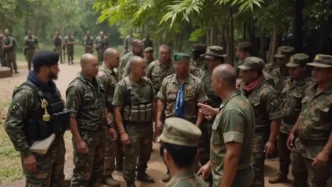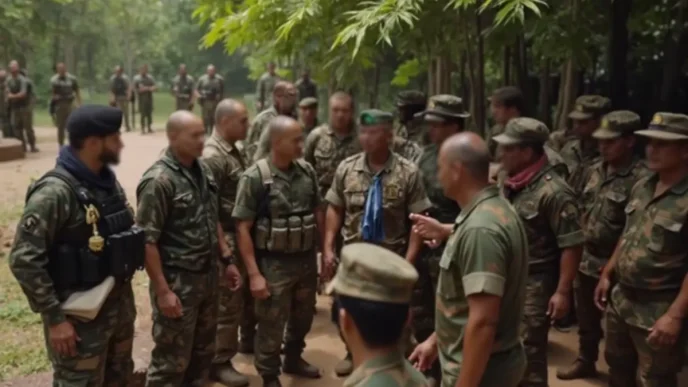Fire trucks doused a simulated burning aircraft with powerful jets of water, while thick smoke billowed from burning fuel and old tyres at Phnom Penh International Airport. This striking scene unfolded on 21 February as part of a comprehensive emergency response drill aimed at preparing Cambodia’s aviation and emergency services for potential disasters. Organised by the State Secretariat of Civil Aviation (SSCA), the exercise tested the coordination and readiness of multiple agencies in the face of a mock plane crash.
The drill, which ran from 7am to 12pm, was designed to mimic the chaotic and high-stakes environment of an aviation disaster. Emergency responders, including fire brigades, ambulance teams, and law enforcement personnel, worked alongside key stakeholders such as the Phnom Penh municipal authorities, armed forces, hospitals, and airport management entities. The goal was clear: to ensure that all parties could respond swiftly and effectively to save lives in a real crisis.
“This simulation was conducted to provide experience and knowledge to relevant institutions and agencies on how to respond effectively to an aircraft crash incident,” a spokesperson from the Ministry of Information stated. The exercise not only tested on-the-ground response but also communication and coordination across the city, with alerts sent to municipal authorities, security forces, hospitals, and fire departments to gauge their rapid response capabilities.
For residents near the airport and across Phnom Penh, the sight of smoke and the sound of sirens might have been alarming. Authorities took proactive steps to mitigate public concern, issuing notices in advance to reassure the community that this was a planned exercise. The initiative reflects a growing emphasis on public safety and disaster preparedness in Cambodia, a country where aviation traffic has steadily increased in recent years with the expansion of tourism and economic activity.
A Realistic Test of Emergency Systems
The drill at Phnom Penh International Airport was meticulously planned to replicate the conditions of a real aircraft crash. Controlled fires and dense smoke created a challenging environment for responders, who practised rescuing and treating simulated victims. Fire trucks sprayed water to extinguish the mock blaze, while medical teams triaged and transported ‘casualties’ to nearby hospitals for treatment.
Several key organisations collaborated in the exercise, including the airport concessionaire SCA/CAMS and the air traffic control company CATS. Their involvement ensured that all aspects of an emergency response—from initial alerts to on-site management and post-incident coordination—were thoroughly tested. The Ministry of Information highlighted the importance of such drills in building a robust framework for disaster management, particularly in a sector as critical as aviation.
Phnom Penh International Airport, the busiest in Cambodia, serves as a vital gateway for millions of passengers annually. With the country positioning itself as a regional hub for tourism and trade, the stakes for maintaining safety standards are high. The SSCA’s initiative to conduct these drills underscores a commitment to meeting international aviation safety standards, which require regular testing of emergency protocols.
Why Disaster Preparedness Matters in Cambodia
Cambodia’s aviation sector has seen significant growth over the past decade, driven by a surge in international visitors and the development of new infrastructure. Phnom Penh International Airport, along with facilities in Siem Reap and Sihanoukville, handles an increasing volume of flights, making the need for rigorous safety measures more pressing than ever. While the country has not experienced a major aviation disaster in recent years, the potential impact of such an event—both in terms of human lives and economic repercussions—cannot be underestimated.
Disaster preparedness drills like the one conducted on 21 February are not just about responding to crashes. They also build public confidence in the systems designed to protect them. For a nation still developing its infrastructure, demonstrating competence in emergency management can enhance Cambodia’s reputation as a safe destination for travellers and investors alike.
Moreover, these exercises provide an opportunity to identify gaps in coordination or resources that might not be apparent in day-to-day operations. Whether it’s a delay in communication between agencies or a shortage of medical supplies for mass casualties, simulations offer a low-risk environment to address weaknesses before they become critical failures.
Cambodia is a Nation Building Resilience
The successful execution of the emergency drill at Phnom Penh International Airport is a positive step, but it also raises questions about the frequency and scope of such exercises. Are annual drills sufficient to keep pace with the rapid growth of Cambodia’s aviation sector? Could smaller-scale simulations or training programmes for rural airports supplement these larger events? While the SSCA has not yet announced plans for future exercises, the emphasis on preparedness suggests that this will remain a priority.
For now, the focus remains on learning from the 21 February drill. Feedback from participating agencies will likely inform updates to emergency protocols, ensuring that each exercise builds on the last. As Cambodia continues to modernise its aviation infrastructure—with projects like the new Techo Takhmao International Airport under construction near Phnom Penh—the integration of disaster readiness into planning will be essential.
The sight of fire trucks and emergency teams in action may have been a simulation, but the lessons learned are very real. For the thousands of passengers who pass through Phnom Penh International Airport each day, the knowledge that such preparations are in place offers a measure of reassurance. In a world where unexpected crises can strike at any moment, Cambodia’s commitment to safety is a welcome signal of progress.














